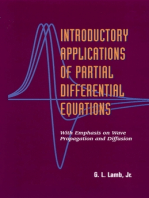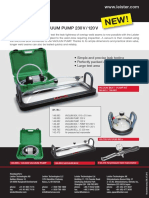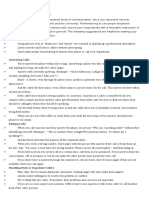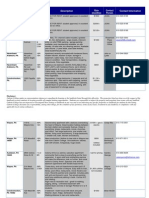0%(1)0% found this document useful (1 vote)
2K viewsRefresh Cathode-Ray Tubes
Refresh Cathode-Ray Tubes
Uploaded by
Areej Al MajedRefresh CRTs can be operated either as random-scan or as raster-scan monitors. The amount of light emitted by the phosphor coating depends on the number of electrons striking the screen. A control knob is available on video monitors to set the brightness for the entire screen.
Copyright:
© All Rights Reserved
Available Formats
Download as PPT, PDF, TXT or read online from Scribd
Refresh Cathode-Ray Tubes
Refresh Cathode-Ray Tubes
Uploaded by
Areej Al Majed0%(1)0% found this document useful (1 vote)
2K views12 pagesRefresh CRTs can be operated either as random-scan or as raster-scan monitors. The amount of light emitted by the phosphor coating depends on the number of electrons striking the screen. A control knob is available on video monitors to set the brightness for the entire screen.
Copyright
© © All Rights Reserved
Available Formats
PPT, PDF, TXT or read online from Scribd
Share this document
Did you find this document useful?
Is this content inappropriate?
Refresh CRTs can be operated either as random-scan or as raster-scan monitors. The amount of light emitted by the phosphor coating depends on the number of electrons striking the screen. A control knob is available on video monitors to set the brightness for the entire screen.
Copyright:
© All Rights Reserved
Available Formats
Download as PPT, PDF, TXT or read online from Scribd
Download as ppt, pdf, or txt
0%(1)0% found this document useful (1 vote)
2K views12 pagesRefresh Cathode-Ray Tubes
Refresh Cathode-Ray Tubes
Uploaded by
Areej Al MajedRefresh CRTs can be operated either as random-scan or as raster-scan monitors. The amount of light emitted by the phosphor coating depends on the number of electrons striking the screen. A control knob is available on video monitors to set the brightness for the entire screen.
Copyright:
© All Rights Reserved
Available Formats
Download as PPT, PDF, TXT or read online from Scribd
Download as ppt, pdf, or txt
You are on page 1of 12
Refresh Cathode-Ray Tubes
Cathode is heated to produce electrons as a cloud.
Control Grid reduces the number of electrons leaving the Cathode =
Brightness Control. A high negative voltage applied to the control
grid will stop the electrons. A smaller negative voltage on the
control grid decreases the number of electrons passing through.
Since the amount of light emitted by the phosphor coating depends
on the number of electrons striking the screen, the brightness of a
display is controlled by varying the voltage on the control grid. A
control knob is available on video monitors to set the brightness for
the entire screen.
Accelerators are used to impart enough energy to produce light
when they strike phosphor.
Focusing Systems in a CRT is needed to force the electron beam to
converge into a small spot as it strikes the phosphor. Otherwise the
electrons will repel each other, and the beam would spread out as it
approaches the screen.
Deflection Systems An electromagnetic field or an electrostatic field
can be used to deflect a stream of electrons in some linear manner.
In electrostatic method, the beam passes between two pair of metal
plates. A voltage difference is applied to each pair of plates
according to the amount that the beam is to be deflected in each
direction.
Fluorescence Light emitted while the phosphor is being struck by
electrons.
Phosphorescence Light emitted once the electron beam is removed.
Resolution
The maximum number of dots (pixels) that can
be displayed without overlap on a CRT is
referred to as resolution.
Resolution of a CRT depends on the type of
phosphor used and the focusing and deflection
systems.
E.g. A 640-by-480 pixel screen is capable of
displaying 640 distinct dots on each of 480 lines,
or about 300,000 pixels. Good quality systems
have a resolution of about 1600X1200 and even
more.
Random-scan & Raster-scan Monitors
Refresh CRTs can be operated either as random-scan or
as raster-scan monitors.
Random-scan Monitors
In Random-scan Monitors, the electron beam is directed
only to parts of the screen where a picture is to be
drawn. These monitors draw a picture one line at a time.
They are also referred as vector displays or calligraphic
displays. The component lines of a picture can be drawn
and refreshed by a random-scan system in any order
specified. This type of system is suited for line-drawing
applications.
A pen plotter is an example of a random-scan hard copy
device.
Raster-scan Monitors
Raster-scan Monitors shoot the electron beam over all
parts of the screen, turning the beam intensity on and off
to coincide with the picture definition. The picture is
created as a set of points starting from the top of the
screen. Definition for a picture is now stored as a set of
intensity values for all the screen points, and these
stored values are painted on the screen one row (scan
line) at a time. These are well suited for displaying
colors & shading. TV sets and Printers are examples of
systems using raster-scan methods.
higher refresh rates are needed.
This is done by interlacing scan lines.
First, all points on the even-numbered
lines are displayed.
Then, all points along the odd-numbered
lines are displayed.
Color CRT Monitors
Beam Penetration Method
Used in Random-scan monitors
Two layers of phosphor (usually red & green) are coated onto the
screen.
The displayed color depends on how far the electron beam
penetrates into the phosphor layers.
A beam of slow electrons emits only the outer red layer.
A beam of very fast electrons penetrates through the red layer and
excites the inner green layer.
At intermediate beam speeds, combinations of red and green light
are emitted to show additional colors, orange & yellow.
Disadvantages
Only 4 colors are possible.
The quality of pictures is not so good.
Shadow Mask Method
Used in Raster-scan systems (including color TV).
The screen is coated with tiny triangular patterns, each containing
three different closely spaced phosphor dots.
One phosphor dot of each triangle emits a red light, another emits a
green light, and the third emits a blue light.
There is a shadow-mask grid just behind the screen, which contains a
series of holes aligned with the phosphor-dot patterns.
There are three electron guns, one for each color dot. The three
beams from the guns are deflected and focused as a group onto the
shadow mask.
When the three beams pass through a hole in the mask, they activate
a dot triangle, which appears as a small color spot on the screen.
The phosphor dots in the triangles are arranged so that each electron
beam can activate only its corresponding color dot.
Advantages
Much wider range of colors.
Clearer character formation.
Better cost/performance.
Direct - View Storage Tube
(DVST)
Primary Gun is used to store the picture pattern.
Flood Gun maintains the picture display.
High-speed electrons from the primary gun strike the
storage grid, knocking out electrons, which are attracted
to the collector grid.
Since the storage grid is non-conducting, the areas
where electrons have been removed will keep a net
positive charge. This stored positive charge pattern on
the storage grid is the picture definition.
The flood gun produces continuous flow of free electrons
that pass through the control grid and are attracted to the
positive areas of the storage grid.
These electrons penetrate through the storage grid to the
phosphor coating.
The finer the grid the higher the resolution of the DVST
(Direct View Storage Tube).
Plasma-Panel Displays
A plasma panel display is made up of millions of phosphor-coated gas-filled
pixel cells. i.e., millions of tiny cells (pixels) containing minute amounts of
gas are sandwiched between two sheets of glass. A series of vertical and
horizontal electrodes, placed on the front and rear glass panels, are used to
light up individual points in the neon. When electrically charged, they
produce an ultraviolet beam, which activates the phosphorous coating of the
cell transmitting light through the glass surface. Color images are produced
with different colors of phosphorous. The result is a totally flat screen with
incredibly brilliant images.
An individual neon point in a plasma panel is turned on by applying a "firing
voltage" of about 120 volts to the pair of electrodes. Once the point is turned
on, the voltage on these electrodes is then lowered to a "sustaining voltage"
level (about 90 volts) that keeps the neon cell glowing. Erasing the screen
is accomplished by lowering the voltage on each electrode below the
sustaining voltage level.
Disadvantages
Number of points that can be displayed by a plasma panel is limited.
High cost than that of a refresh CRT.
Advantages
No refreshing is required.
They have flat screens and are transparent, so displayed images can be
superimposed with pictures from slides.
LED and LCD Monitors
LED and LCD Monitors
Two other technologies used in the design of graphics monitors are
light emitting diodes (LED) and liquid-crystal displays (LCDs).
These devices use light emitted from diodes or crystals instead of
phosphors or neon gas to display a picture. LEDs and LCDs are
particularly useful in the design of miniscreens used with some
graphic games.
LCD Vs CRT
There is no flicker on an LCD display because, while a CRT must
be refreshed, the LCD has a constant source of light over the whole
screen. Once a pixel is on, it stays on until turned off.
The image is always perfectly "focused" over the entire screen.
The amount of heat generated by an LCD monitor is considerably
less than a CRT monitor, resulting in a lower load on air
conditioning.
LCD Monitors offers brightness twice (approximately) than that of a
CRT Monitor
LCD Monitors have less size and weight when compared to CRT
Monitors
You might also like
- Test Management Tools Testlink Tutorial: WWW - Cs.ubbcluj - Ro/ AvescanDocument8 pagesTest Management Tools Testlink Tutorial: WWW - Cs.ubbcluj - Ro/ AvescanSapte MelisaNo ratings yet
- Self Running Free Energy Device Muller Motor Generator Romerouk Version1 1Document25 pagesSelf Running Free Energy Device Muller Motor Generator Romerouk Version1 1Hydrostatic0013100% (5)
- "Informal Institutions Rule" Williamson Article ReviewDocument2 pages"Informal Institutions Rule" Williamson Article ReviewSamy Hamdane100% (1)
- En 10327-2004 PDFDocument25 pagesEn 10327-2004 PDFNguyễn Xuân Điệp100% (1)
- MEM201Thermodynamics QB (2018-19) With Syllabus-1 PDFDocument10 pagesMEM201Thermodynamics QB (2018-19) With Syllabus-1 PDFRohan DubeyNo ratings yet
- Newton's Rings Manual - BBS - SPPDocument5 pagesNewton's Rings Manual - BBS - SPPVickeyNo ratings yet
- Where, C Speed of Light: Wave Length F FrequencyDocument35 pagesWhere, C Speed of Light: Wave Length F FrequencybalakaleesNo ratings yet
- Engineering Thermodynamics: Experiment# 08 (Open Ended Lab)Document17 pagesEngineering Thermodynamics: Experiment# 08 (Open Ended Lab)kashmiri food and culture and bunkNo ratings yet
- Adv Survay 2Document21 pagesAdv Survay 2AshenPereraNo ratings yet
- Natural Convection Lab ManualDocument12 pagesNatural Convection Lab Manualjohn paul.jaisonNo ratings yet
- Internship PresentationDocument26 pagesInternship PresentationKarthik NayakNo ratings yet
- Cam and Follower GuntDocument20 pagesCam and Follower GuntAurangzebNo ratings yet
- NV6111Document23 pagesNV6111దేవల్ రాజు మహేష్ రాజుNo ratings yet
- Angular Momentum Principles - Fluid MechanicsDocument14 pagesAngular Momentum Principles - Fluid Mechanicsing_manceraNo ratings yet
- ARESDocument64 pagesARESHarshal SonarNo ratings yet
- PID QuestionsDocument5 pagesPID QuestionsnivasssvNo ratings yet
- Module 3 Axisymmetric Problems 4th Sem MOM (ME181405) Under ASTU - Part IIDocument35 pagesModule 3 Axisymmetric Problems 4th Sem MOM (ME181405) Under ASTU - Part IIDEBOJIT SONOWALNo ratings yet
- CH 9 Flow Over Immersed BodiesDocument120 pagesCH 9 Flow Over Immersed BodiesMahesh LohanoNo ratings yet
- Magneto Hydro Dynamics (MHD) Power GenerationDocument14 pagesMagneto Hydro Dynamics (MHD) Power GenerationVishal Subhash patilNo ratings yet
- Process ControlDocument20 pagesProcess ControlRexel Reedus100% (1)
- Me Lab 1 ExperimentDocument4 pagesMe Lab 1 ExperimentErikShun0% (1)
- Bi Quartz PolarimeterDocument3 pagesBi Quartz PolarimeterNikitaNo ratings yet
- ME424 201516 Unit4 PDFDocument56 pagesME424 201516 Unit4 PDFharshaNo ratings yet
- NumericalsDocument46 pagesNumericalsSubra Pratik RoutNo ratings yet
- Evdp Ass SolutionDocument6 pagesEvdp Ass SolutionPratik008No ratings yet
- Experiment No. 1 Linear System SimulatorDocument2 pagesExperiment No. 1 Linear System Simulatorlova56100% (1)
- 63960Document31 pages63960amdevaNo ratings yet
- Department of Mechanical Engineering Mechatronics Lab Viva QuestionsDocument1 pageDepartment of Mechanical Engineering Mechatronics Lab Viva QuestionsPushpa Mohan RajNo ratings yet
- Forced Convection Lab ManualDocument10 pagesForced Convection Lab Manualjohn paul.jaisonNo ratings yet
- KDM - Mechanisms and Machines - CompleteDocument53 pagesKDM - Mechanisms and Machines - CompleteBiswajit SahuNo ratings yet
- Heat Transfer Review QuestionsDocument3 pagesHeat Transfer Review QuestionsSaniya JumaniNo ratings yet
- Mechatronics Lab ManualDocument73 pagesMechatronics Lab ManualSwapvaibNo ratings yet
- MCQ Module 1 RGPV Mathematics IIIDocument7 pagesMCQ Module 1 RGPV Mathematics IIIPawari Ho rhi hNo ratings yet
- Tutorial Sheet 2Document1 pageTutorial Sheet 2Supriya YadavNo ratings yet
- Control Engineering RevisionDocument4 pagesControl Engineering Revisionemlynmuriuki29No ratings yet
- Venturimeter, Orificemeter & Rotameter Calibration Set-Up: Experiment No. 4Document9 pagesVenturimeter, Orificemeter & Rotameter Calibration Set-Up: Experiment No. 4Somya MaheshwariNo ratings yet
- Root Locus MethodDocument23 pagesRoot Locus MethodChanoxismNo ratings yet
- Experiment No. 05 Bi-Quartz Polarimeter: Prepared By: Department of Physics Medi-Caps University, IndoreDocument16 pagesExperiment No. 05 Bi-Quartz Polarimeter: Prepared By: Department of Physics Medi-Caps University, IndorePrabal Pratap Singh ThakurNo ratings yet
- FCPC NotesDocument147 pagesFCPC Notesspeed_a5987100% (1)
- Refrigeration and Air-Conditioning - Unit 4 - Week-3Document4 pagesRefrigeration and Air-Conditioning - Unit 4 - Week-3Kali DassNo ratings yet
- CNC Report Bhel Haridwar Summer Training Report Electronic & CommunicationDocument29 pagesCNC Report Bhel Haridwar Summer Training Report Electronic & Communicationritika_arora19067% (3)
- Separation of VariablesDocument13 pagesSeparation of VariablesxingmingNo ratings yet
- Signal Flow GraphDocument16 pagesSignal Flow GraphSrinivasan PrakashNo ratings yet
- Bcme Unit-III NotesDocument17 pagesBcme Unit-III Noteschirlagunasekharreddy77No ratings yet
- ME405 RAC Question BankDocument8 pagesME405 RAC Question BankDeepakNo ratings yet
- Measurement of Internal Radius by A Slip Gauge 3Document9 pagesMeasurement of Internal Radius by A Slip Gauge 3sen_subhasis_58No ratings yet
- Lab Report Triffilliarc PDFDocument17 pagesLab Report Triffilliarc PDFsohail parachaNo ratings yet
- RC CoupledDocument3 pagesRC CoupledRavi TejaNo ratings yet
- Online Session With 2 Year Students Department of Statistics, BSMRSTUDocument9 pagesOnline Session With 2 Year Students Department of Statistics, BSMRSTUTaanzNo ratings yet
- Axial Flow TurbinesDocument26 pagesAxial Flow Turbineskarateca17No ratings yet
- Lab Manual (TME-426) Non-Conventional Energy Sources and SystemsDocument30 pagesLab Manual (TME-426) Non-Conventional Energy Sources and SystemsJITENDRA SINGH100% (1)
- Electronic Devices and Integrated Circuits - Operational Amplifier - SOLVED PROBLEMS - Safari Books OnlineDocument34 pagesElectronic Devices and Integrated Circuits - Operational Amplifier - SOLVED PROBLEMS - Safari Books Onlinemuhaned190100% (1)
- Steam Nozzles - Gss - Unit5 PDFDocument41 pagesSteam Nozzles - Gss - Unit5 PDFkavya nainitaNo ratings yet
- Dual Slope Integrating Type DVMDocument4 pagesDual Slope Integrating Type DVMmohit100% (1)
- Root Locus PDFDocument18 pagesRoot Locus PDFUM Zaid100% (1)
- Feedback Control of Dynamic Systems SummaryDocument30 pagesFeedback Control of Dynamic Systems Summaryjbremmers100% (1)
- Acd Lab ManualDocument31 pagesAcd Lab Manualdestro29No ratings yet
- Module 1 SiliconDocument4 pagesModule 1 SiliconTriveni M KNo ratings yet
- Eme Question BankDocument13 pagesEme Question Bankapi-315791751No ratings yet
- Introductory Applications of Partial Differential Equations: With Emphasis on Wave Propagation and DiffusionFrom EverandIntroductory Applications of Partial Differential Equations: With Emphasis on Wave Propagation and DiffusionNo ratings yet
- Video Display DevicesDocument66 pagesVideo Display DevicesshabanaNo ratings yet
- Display DevicesDocument78 pagesDisplay DevicesSweta SipraNo ratings yet
- 2.display System ColoredDocument24 pages2.display System ColoredGeetansh SharmaNo ratings yet
- Evolution of Computer GraphicsDocument41 pagesEvolution of Computer GraphicsGeetika BhardwajNo ratings yet
- Exercise, Bresemham Line Drawing Algorithm PDFDocument1 pageExercise, Bresemham Line Drawing Algorithm PDFAreej Al MajedNo ratings yet
- Computer Graphics - Activity 1 Sem1 (2019-2020)Document1 pageComputer Graphics - Activity 1 Sem1 (2019-2020)Areej Al MajedNo ratings yet
- 8086 Lab ExercisesDocument39 pages8086 Lab ExercisesAreej Al MajedNo ratings yet
- DFD Problems and Exercises SolutionsDocument6 pagesDFD Problems and Exercises SolutionsHeatstrokeNo ratings yet
- Assignment No 2 Last Date: 24/6/2013Document6 pagesAssignment No 2 Last Date: 24/6/2013Areej Al MajedNo ratings yet
- Web Services and SOA Arch Using Mobile Tech - Outcomes - 20!05!14Document1 pageWeb Services and SOA Arch Using Mobile Tech - Outcomes - 20!05!14Areej Al MajedNo ratings yet
- Basis Path Testing PaperDocument22 pagesBasis Path Testing PaperAreej Al MajedNo ratings yet
- Metrics: Original Prepared By: Sudipto Ghosh Revised: Aditya MathurDocument45 pagesMetrics: Original Prepared By: Sudipto Ghosh Revised: Aditya MathurAreej Al MajedNo ratings yet
- ITDB 3111-Module1Document12 pagesITDB 3111-Module1Areej Al MajedNo ratings yet
- Stubs and DriversDocument4 pagesStubs and DriversAreej Al MajedNo ratings yet
- Outcomes Software DesignDocument1 pageOutcomes Software DesignAreej Al MajedNo ratings yet
- Mob: +968 95569000 or +968 99458823 Barakat Moh'd Tawfeeq Nusair Personal InformationDocument3 pagesMob: +968 95569000 or +968 99458823 Barakat Moh'd Tawfeeq Nusair Personal InformationAreej Al MajedNo ratings yet
- An Appropriate Sequence For Risk Management Activities IsDocument2 pagesAn Appropriate Sequence For Risk Management Activities IsAreej Al MajedNo ratings yet
- Path Testing SolutionDocument4 pagesPath Testing SolutionAreej Al MajedNo ratings yet
- V 100 KMHDocument40 pagesV 100 KMHHendry Nur ApriyantoNo ratings yet
- CREW Versus EXECUTIVE OFFICE OF THE PRESIDENT ET AL (Lawsuit) : EOP0000292Document3 pagesCREW Versus EXECUTIVE OFFICE OF THE PRESIDENT ET AL (Lawsuit) : EOP0000292CREWNo ratings yet
- Running Head: Case Analysis: Google in China 1Document5 pagesRunning Head: Case Analysis: Google in China 1Kipkemboi2No ratings yet
- Finding An Apartment Project: Background - Answer These Questions in Complete SentencesDocument4 pagesFinding An Apartment Project: Background - Answer These Questions in Complete Sentencesapi-288310744No ratings yet
- SCU Harvard Referencing Style - 2019 PDFDocument14 pagesSCU Harvard Referencing Style - 2019 PDFLawanNo ratings yet
- High Voltage Impulse Generator Using HV-IGBTsDocument5 pagesHigh Voltage Impulse Generator Using HV-IGBTsMusharaf Saeed100% (1)
- OpenSees Days Berkeley 13 OSNDocument71 pagesOpenSees Days Berkeley 13 OSNbladeyusNo ratings yet
- AMI Systems Design 1Document28 pagesAMI Systems Design 1oso0969No ratings yet
- Sjzl20060678-Unitrans ZXMP S385 (V2.00&V2.10) Technical ManualDocument128 pagesSjzl20060678-Unitrans ZXMP S385 (V2.00&V2.10) Technical ManualFaithful Friend100% (1)
- Grade 10 - Arts q2Document20 pagesGrade 10 - Arts q2Mary Karen Lachica Catunao83% (6)
- Re 530 CatalogDocument12 pagesRe 530 CatalogCarlos Antonio Gonzalez MendozaNo ratings yet
- Pure Dynamism - Cryostar Magazine5Document12 pagesPure Dynamism - Cryostar Magazine5Narayan MarndiNo ratings yet
- Service Manual: Auto WasherDocument42 pagesService Manual: Auto WasherGiancarloRichardRivadeneyraMirandaNo ratings yet
- Caja de VacioDocument1 pageCaja de Vaciojaime huertasNo ratings yet
- Prem's ResumeDocument1 pagePrem's ResumePrem KalevarNo ratings yet
- Hydraulic Brake Booster Installation LC 200Document17 pagesHydraulic Brake Booster Installation LC 200Yannick de WalqueNo ratings yet
- Telephone Etiquette: Answering CallsDocument2 pagesTelephone Etiquette: Answering CallsRICHDALE DEJITONo ratings yet
- Noise Reduction in Hvac Duct SystemsDocument27 pagesNoise Reduction in Hvac Duct SystemsQOBITNo ratings yet
- Fluoroelastomer Stress Induced CrackingDocument22 pagesFluoroelastomer Stress Induced CrackingSid ShahNo ratings yet
- Dual Pre-Amp & A/B Box: Designed by Rick BarkerDocument1 pageDual Pre-Amp & A/B Box: Designed by Rick BarkerВиталий ИвановNo ratings yet
- Bti BX30Document1 pageBti BX30AS LO ProveedoresNo ratings yet
- Cabrini Off-Campus-Housing 2009 2010Document17 pagesCabrini Off-Campus-Housing 2009 2010thereadingshelfNo ratings yet
- GXCF35GBS 856961214Document32 pagesGXCF35GBS 856961214Antonio HGNo ratings yet
- DBMS Interview QuestionsDocument18 pagesDBMS Interview QuestionsviswasknitNo ratings yet
- LA Clark App BDocument5 pagesLA Clark App Bmatie12345No ratings yet
- Assignment 2OOPDocument1 pageAssignment 2OOPFarrukh KhanNo ratings yet







































































































